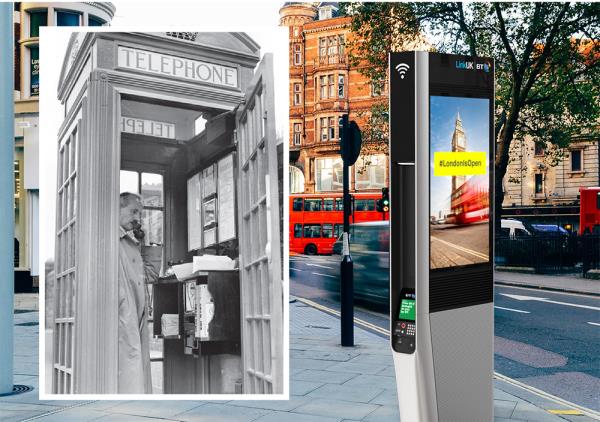10 April 2017

Left: the familiar K6 telephone box or ‘Jubilee Kiosk’ was designed by English architect Sir Giles Gilbert Scott and first introduced in 1936 to commemorate King George V’s Silver Jubilee. There are still around 8,000 of these traditional red phone boxes in the UK of which 2,400 are designated as grade II listed buildings. Right: at least 750 Links kiosks will be installed across central London and in major cities across the UK over the next few years.
Residents, visitors and businesses in the London borough of Southwark are set to benefit from the fastest free public Wi-Fi available, free calls, and a range of other free digital services on the street, following a partnership between BT, Intersection, and outdoor advertising company Primesight.
Southwark is home to a number of London’s most iconic tourist attractions, such as Tower Bridge, the Shard skyscraper, the Tate Modern art gallery, amongst many others. It will join Camden as one of the first areas where BT’s new LinkUK service will be rolled out in the capital.
The sleek looking Links kiosks will be installed on high streets across the borough and will take up less space than the payphones they replace.
BT says hundreds of users within their range will be able to access free ultrafast Wi-Fi on the move, with speeds of up to 1Gbps – the fastest free public Wi-Fi service available.
Other free services will include UK landline and mobile calls, rapid mobile device charging, online maps, directions and local information.
BT says all these services will come at no cost to users or taxpayers as they will be funded by revenues from advertising on the Links’ digital displays. Each kiosk will feature two 55-inch HD screens that can display public service announcements as well as advertising for businesses.
They will also feature sensors that can capture real-time data relating to the local environment. This could include, for example, air and noise pollution, outdoor temperature and traffic conditions.
BT says this offers the potential of introducing a new range of smart services to local councils and communities based on the Internet of Things.
“This is the phone box of the future,” says Nick Hale, MD Ventures, BT Wholesale and Ventures. “We’re evolving the phone box to make it relevant to people in the 21st century.”
At least 750 Links kiosks are expected to be installed across central London and in major cities across the UK over the next few years. More than 100 will be installed in Southwark, with the first ones due to appear later in 2017. All the partners are working with councils and local communities to determine the best location for each Link.
Links were first installed in New York City early last year as part of LinkNYC. The leading consortium behind this venture is Intersection. It describes itself as “an urban innovation company that integrates data, connectivity, and media in public spaces to drive revenues efficiencies and better customer experiences for cities, citizens and brands”.
Intersection is run by a group of investors led by Sidewalk Labs which is in turn owned by Alphabet, Google’s parent company.
With more than 600 Links now operating, LinkNYC recently reached the milestone of more than one million registered users connected to its ultrafast Wi-Fi service.










